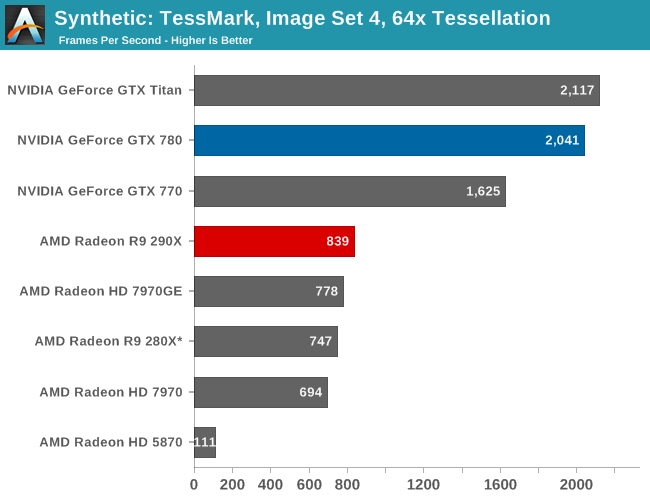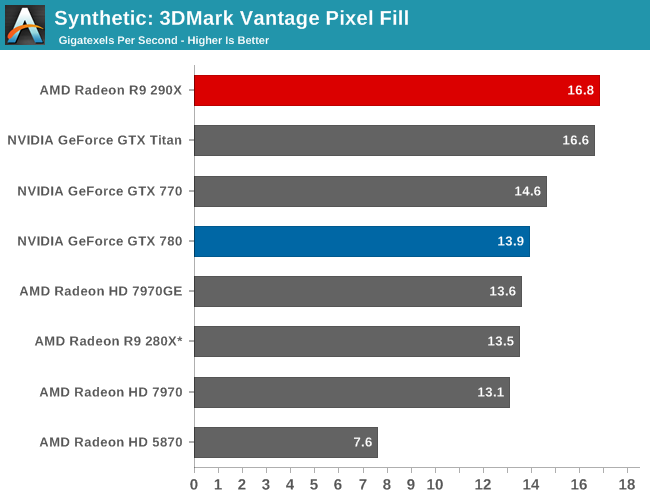The AMD Radeon R9 290X Review
by Ryan Smith on October 24, 2013 12:01 AM EST- Posted in
- GPUs
- AMD
- Radeon
- Hawaii
- Radeon 200
Synthetics
As always we’ll also take a quick look at synthetic performance. The 290X shouldn’t pack any great surprises here since it’s still GCN, and as such bound to the same general rules for efficiency, but we do have the additional geometry processors and additional ROPs to occupy our attention.

Right off the bat then, the TessMark results are something of a head scratcher. Whereas NVIDIA’s performance here has consistently scaled well with the number of SMXes, AMD’s seeing minimal scaling from those additional geometry processors on Hawaii/290X. Clearly Tessmark is striking another bottleneck on 290X beyond simple geometry throughput, though it’s not absolutely clear what that bottleneck is.
This is a tessellation-heavy benchmark as opposed to a simple massive geometry bencehmark, so we may be seeing a tessellation bottleneck rather than a geometry bottleneck, as tessellation requires its own set of heavy lifting to generate the necessary control points. The 12% performance gain is much closer to the 11% memory bandwidth gain than anything else, so it may be that the 280X and 290X are having to go off-chip to store tessellation data (we are after all using a rather extreme factor), in which case it’s a memory bandwidth bottleneck. Real world geometry performance will undoubtedly be better than this – thankfully for AMD this is the pathological tessellation case – but it does serve of a reminder of how much more tessellation performance NVIDIA is able to wring out of Kepler. Though the nearly 8x increase in tessellation performance since 5870 shows that AMD has at least gone a long way in 4 years, and considering the performance in our tessellation enabled games AMD doesn’t seem to be hurting for tessellation performance in the real world right now.
Moving on, we have our 3DMark Vantage texture and pixel fillrate tests, which present our cards with massive amounts of texturing and color blending work. These aren’t results we suggest comparing across different vendors, but they’re good for tracking improvements and changes within a single product family.

Looking first at texturing performance, we can see that texturing performance is essentially scaling 1:1 with what the theoretical numbers say it should. 36% better texturing performance over 280X is exactly in line with the increased number of texture units versus 280X, at the very least proving that 290X isn’t having any trouble feeding the increased number of texture units in this scenario.

Meanwhile for our pixel fill rates the results are a bit more in the middle, reflecting the fact that this test is a mix of ROP bottlenecking and memory bandwidth bottlenecking. Remember, AMD doubled the ROPs versus 280X, but only gave it 11% more memory bandwidth. As a result the ROPs’ ability to perform is going to depend in part on how well color compression works and what can be recycled in the L2 cache, as anything else means a trip to the VRAM and running into those lesser memory bandwidth gains. Though the 290X does get something of a secondary benefit here, which is that unlike the 280X it doesn’t have to go through a memory crossbar and any inefficiencies/overhead it may add, since the number of ROPs and memory controllers is perfectly aligned on Hawaii.










396 Comments
View All Comments
xres625e - Thursday, October 24, 2013 - link
sterven..eddieveenstra - Sunday, October 27, 2013 - link
stoere jongen ben je.... bah.TrantaLocked - Sunday, October 27, 2013 - link
Hm I wonder why I can find the 290X for $550 on newegg?Dal Makhani - Thursday, October 24, 2013 - link
lol AMD fanboy. This card is alright, nothing "uber". It brings some proper pricing sense back into the green team's head which is needed, the gtx 780 will be dropped to R9 290X pricing, and the 780 Ti will be Nvidia's new 650 dollar card. But to justify 100 dollar price difference, i dont know if 780 Ti can show big enough gains. That will be interesting to see next month.tuklap - Thursday, October 24, 2013 - link
I doubt that nvidia gtx 780 will drop price on par with r9 290x..just4U - Thursday, October 24, 2013 - link
I doubt it as well.. They didn't ever really drop prices on the 560Ti until it EOL..mfergus - Thursday, October 24, 2013 - link
Well it's uber in the sense that it brings much needed competition to Nvidia's very high priced high end cards. Nobody should of thought this card was going to be revolutionary though, it's on the same 28nm as all the other cards and it has the same architecture as the 7790 which had very minor compute changes compared to GCN 1.0dragonsqrrl - Thursday, October 24, 2013 - link
Dropping the 780 by $100 is the very least Nvidia would have to do to remain competitive, and personally I don't think that would be nearly enough. The 290X is performance competitive with Titan, and despite the fact that Titan is cooler, quieter, consumes less power, has a much better shroud, and superior DP performance, it should come down to the same price as the 290X to remain competitive due to the slightly higher performance of the 290X. A ~$550 Titan or ~$400 780 would be amazing.mfergus - Thursday, October 24, 2013 - link
I don't expect Titan's price to change much but I could be wrong. I never really thought of it as a standard gaming card, it's a total halo product with lots of memory and the only non Quadro/Tesla with full DP performance. The 780ti will be cheaper than Titan though and faster in gaming performance.Bloodcalibur - Thursday, October 24, 2013 - link
You truly are an idiot if you think that the Titan should be compared to a 290X and that the sentence ends there. The Titan itself only performs a small bit above nvidia's own 780, but the $350 price difference is there for it's compute performance. It's basically a budget workstation card with higher than 780 gaming abilities for those who game AND do a little bit of 3D computing. Derp.This retard actually suggested a gaming/workstation hybrid pried at $1000 should compete downwards with a $550 gaming card.